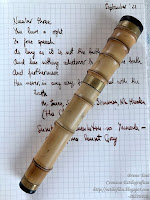And what these affordable pens show is that not much is needed to create a commemorative edition: engrave a descriptive text on the body or on the nib of a regular model and claim it is a very limited release.
But there was a time, not that long ago, when Pilot –and other brands-- used anniversary pens to try new products and test the market. Such was the case of the 65th anniversary pen—the first modern balance model by Pilot--, or the Shijin pair for the 80th anniversary, later to become the Namiki Yukari Royale and Namiki Urushi 20; to name just a couple of them.
This strategy could understandably imply higher selling prices, but on this recent occasion –and big one it was--, Pilot followed a more traditional approach. Pilot chose a couple of well known canvases and decorated them lavishly and sold them at a premium—no innovation, no affordable prices. There was, though, an exception—the seven ring-top pens with maki-e decoration in a very limited edition of 25 set, but their prices were simply obscene (USD 48000).
But Pilot did make affordable anniversary pens!
The side effect might be that these quasi secret pens might become all the more valuable in some years given their obscurity.
Pilot Custom 74-Yamada Seisakuzho – Diamine Graphite
Bruno Taut
September 10th, 2022
etiquetas: Pilot, mercado
Bruno Taut
September 10th, 2022
etiquetas: Pilot, mercado







































